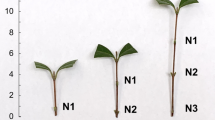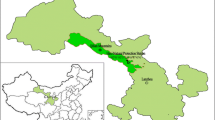Abstract
Two-leaf, two-node cuttings were taken fromEucalyptus grandis stockplants grown under different light qualities (red to far-red ratios of 0.4, 0.7, 1.3, 3.5 and 6.5) at a constant photon flux density (200 μmol m-2 s-1). Two experiments tested effects of pre-severance light quality on cutting morphology, post-severance gas exchange, carbohydrate status and rooting of cuttings. The best rooting percentage was achieved by cuttings with longer stems and greater stem volume from stockplants grown at lower red to far-red (R∶FR) ratios. Generally, rooting success was associated with low pre-severance starch and water-soluble sugar concentrations, and a greater total water-soluble carbohydrate (TWSC) content per cutting. Rooting was associated with well maintained stem starch and an increase in stem TWSC during the propagation period. Gas exchange of cuttings was measured between 28 and 33 days after severance. Rooting percentages at 35 days after severance were positively and linearly related to net photosynthetic rate and stomatal conductance. In unrooted cuttings there was a net release of CO2 which increased significantly with an increase in pre-severance R∶FR ratio. These results demonstrate that stockplant environment may significantly modify the morphology and physiology of subsequent cuttings, and that cutting morphology, and stored and current photosynthates have a significant influence on rooting.
Similar content being viewed by others
References
Bertram L, Veierskov B (1989) A relationship between irradiation, carbohydrates and rooting in cuttings ofPisum sativum. Physiol Plant 76: 81–85
Blake TJ, Filho WS (1988) Drought tolerance, growth partitioning and vigour in eucalypt seedlings and rooted cuttings. Tree Physiol 4: 325–335
Caemmerer S von, Farquhar GD (1981) Some relationships between the biochemistry of photosynthesis and the gas exchange of leaves. Planta 153: 376–387
Davis TD (1988) Photosynthesis during adventitious rooting. In: Davis TD, Haissig BE, Sankhla N (eds) Adventitious root formation in cuttings. Advanced plant science series, vol 2. Dioscorides Press, Portland, Oregon, USA, pp 79–87
Davis TD, Potter JR (1981) Current photosynthate as a limiting factor in adventitious root formation on leafy pea cuttings. J Am Hort Sci 106: 278–282
Davis TD, Potter JR (1989) Relations between carbohydrate, water status and adventitious root formation in leafy pea cuttings rooted under various levels of atmospheric CO2 and relative humidity. Physiol Plant 77: 185–190
Dick JMcP, East K (1992) The influence of light quality on growth and rooting ofAcacia tortilis, a semi-arid tree species of East Africa. Nitrogen Fixing Tree Res Reports 1: 97–101
Dick JMcP, East K, Leakey RRB, Mason PA (1991) The influence of propagation environment and cutting length on the rooting ofProsopis juliflora (Swartz) D.C. Nitrogen Fixing Tree Res Reports 1: 214–216
Eliasson L (1971) Adverse effect of shoot growth on root growth in rooted cuttings of aspen. Physiol Plant 25: 268–272
Eliasson L, Brunes L (1980) Light effects on root formation in aspen and willow cuttings. Physiol Plant 48: 78–82
Fuller KW (1966) Automated determination of sugars. Autom Anal Chem 2: 57–67
Haissig BE (1989a) Removal of the stem terminal and application of auxin change carbohydrates inPinus banksiana cuttings during propagation. Plant Physiol 77: 179–184
Haissig BE (1989b) Carbohydrate relations during propagation of cuttings from sexually maturePinus banksiana trees. Tree Physiol 5: 319–328
Haissig BE (1990) Reduced irradiance and applied auxin influence carbohydrate relations inPinus banksiana cuttings during propagation. Physiol Plant 78: 455–461
Hansen J, Eriksen EN (1974) Root formation of pea cuttings in relation to the irradiance of the stockplants. Physiol Plant 32: 170–173
Hansen J, Strömquist LH, Ericsson A (1978) Influence of the irradiance on carbohydrate content and rooting of cuttings on pine seedlings (Pinus sylvestris L.). Plant Physiol 61: 975–979
Hess CE, Synder WE (1955) A physiological comparison of the use of mist with other propagation procedures used in rooting cuttings. Rept 14th Int Hortic Cong pp 1133–1139
Hoad SP, Leakey RRB (1994) Effects of pre-severance light quality on the vegetative propagation ofEucalyptus grandis W. Hill ex Maiden. Stockplant gas exchange and dry matter partitioning between shoots and their leaves and stems. For Ecol Manage 70: 265–273
Kwesiga FR, Grace J, Sandford AP (1986) Some photosynthetic characteristics of tropical timber trees as affected by the light regime during growth. Ann Bot 58: 23–32
Leakey RRB (1983) Stockplant factors affecting root initiation in cuttings ofTriplochiton scleroxylon K. Schum., an indigenous hardwood of West Africa. J Hort Sci 58: 277–290
Leakey RRB (1985) The capacity for vegetative propagation in trees. In: Cannell MGR, Jackson JE (eds) Attributes of trees as crop plants. Institute of Terrestrial Ecology, Huntington, UK, pp 110–133
Leakey RRB, Coutts M (1989) The dynamics of rooting inTriplochiton scleroxylon K. Schum. cuttings: their relation to leaf area, node position, dry weight accumulation, leaf water potential and carbohydrate composition. Tree Physiol 5: 135–146
Leakey RRB, Longman KA (1988) Low-technology cloning of tropical trees. Appropr Technol 15: 6
Leakey RRB, Mohammed HRS (1985) Effects of stem length on root initiation in sequential cuttings ofTriplochiton scleroxylon K. Schum. J Hort Sci 60: 431–437
Leakey RRB, Storeton-West R (1992) The rooting abilityTriplochiton scleroxylon K. cuttings: interactions between stockplant irradiance, light quality and nutrients. For Ecol Manage 49: 133–150
Leakey RRB, Chapman VR, Longman KA (1982) Physiological studies for tropical tree improvement and conservation. Factors affecting root initiation in cuttings ofTriplochiton scleroxylon L. Schum. For Ecol Manage 4: 53–66
Mead R, Curnow RN (1983) Statistical methods in agriculture and experimental biology. Chapman and Hall, London, pp 33–46
Moe R, Andersen AS (1988) Stockplant environment and subsequent adventitious rooting. In: Davis TD, Haissig BE, Sankhla N (eds) Adventitious root formation of cuttings. Advances in plant science series, vol 2. Dioscorides Press, Portland, Oregon, pp 214–234
Newton AC, Muthoka PN, Dick JMcP (1992a) Rooting physiology of leaf stem cuttings ofTerminalia spinosa Engl. Trees 6: 210–215
Newton AC, Mesen JF, Dick JMcP, Leakey RRB (1992b) Low technology propagation of tropical trees: rooting physiology and its practical implications. In: Mass production technology for genetically improved fast growing tree species. Proceedings of the AFOCEL-IUFRO Symposium, Bordeaux, France, 14–18 September 1992
Okoro OO, Grace J (1976) The physiology of rootingPopulus cuttings. I. Carbohydrates and photosynthesis. Physiol Plant 36: 133–138
Smith D (1969) Removing and analysing total non-structural carbohydrates from plant tissue. Research Report 41. College of Agriculture and Life Sciences. University of Wisconsin, USA, pp 1–11
Smith H (1982) Light quality, photoreception, and plant strategy. Annu Rev Plant Physiol 33: 481–518
Smith H, Whitelam GC (1990) Phytochrome, a family of photoreceptors with multiple physiological roles. Plant Cell Environ 13: 695–707
Veierskov B, Andersen AS (1982) Dynamics of extractable carbohydrates inPisum sativum. III. The effect of IAA and temperature on content and translocation of carbohydrates in pea cuttings during rooting. Physiol Plant 55: 179–182
Veierskov B, Andersen, AS, Eriksen EN (1982a) Dynamics of extractable carbohydrates inPisum sativum. I. Carbohydrate and nitrogen content in pea plants and cuttings grown at two different irradiances. Physiol Plant 55: 167–173
Veierskov B, Andersen AS, Stummann, BM, Henningsen KW (1982b) Dynamics of extractable carbohydrates inPisum sativum. II. Carbohydrate content and photosynthesis of pea cuttings in relation to irradiance and stock plant temperature and genotype. Physiol Plant 55: 174–178
Warrington IJ, Rook DA, Morgan DC, Turnbull HL (1989) The influence of simulated shadelight and daylight on growth, development and photosynthesis ofPinus radiata, Agathis australis andDicarydium cupressinum. Plant Cell Environ 12: 343–356
Author information
Authors and Affiliations
Additional information
ITE is a component of the Edinburgh Centre for Tropical Forestry
Rights and permissions
About this article
Cite this article
Hoad, S.P., Leakey, R.R.B. Effects of pre-severance light quality on the vegetative propagation ofEucalyptus grandis W. Hill ex Maiden. Trees 10, 317–324 (1996). https://doi.org/10.1007/BF02340778
Received:
Accepted:
Issue Date:
DOI: https://doi.org/10.1007/BF02340778




